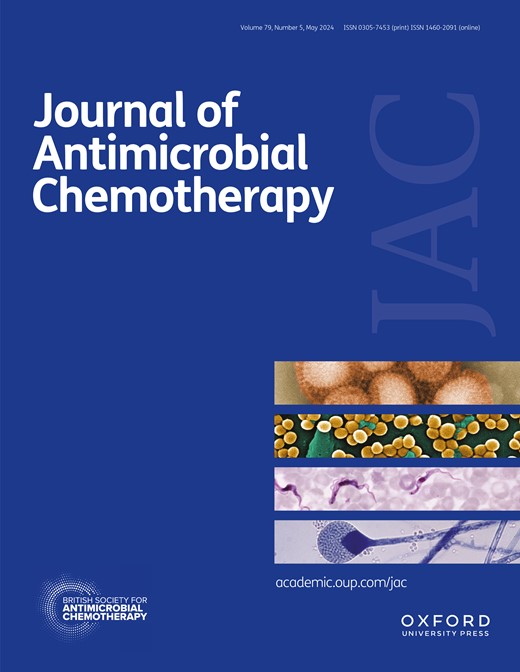需要间歇性高通量血液透析的住院感染患者体内非结合型头孢唑啉的群体药代动力学:每周三次的透析后给药方案能否提供最佳治疗?
IF 3.9
2区 医学
Q1 INFECTIOUS DISEASES
引用次数: 0
摘要
目的描述需要进行间歇性血液透析(IHD)的感染性住院患者体内头孢唑啉的群体药代动力学。方法这项前瞻性群体药代动力学研究针对每周三次、每次 2 克头孢唑啉处方的 IHD 患者进行。在预先指定的时间点采集血浆样本,并使用有效的液相色谱法检测总浓度和非结合浓度。使用 Pmetrics® 进行药代动力学建模和剂量模拟。针对不同的给药方案,模拟了血浆中适合 MSSA 的 PTA(72 小时间隔中最后 24 小时的非结合谷浓度≥2 mg/L)。结果从 16 名中位数年龄为 51 岁的患者(14 名女性)中共收集到 260 个头孢唑啉浓度(130 个总浓度,130 个非结合浓度)。3天剂量间隔谷值的透析前头孢唑啉非结合浓度中位数(IQR)为17.7(13.5-31.4)毫克/升。未结合部分的中位数(IQR)为 0.38(0.32-0.46)。透析前最低未结合浓度为 9.1 毫克/升。具有复杂蛋白结合成分的二室模型充分描述了数据。IHD期间头孢唑啉的平均未结合浓度为16.4 ± 4.26升/小时,而停止透析时为0.40 ± 0.19升/小时。血液透析时间(TOH)是最终模型中唯一支持的协变量。每周三次、每次 2 克的治疗方案与 PTA 为 99.7% 的用药模拟相关,以维持未结合浓度≥2 毫克/升,TOH 为 6 个月。结论对于 MSSA 感染,支持每周三次、每次 1 克的透析后头孢唑啉治疗方案。本文章由计算机程序翻译,如有差异,请以英文原文为准。
Population pharmacokinetics of unbound cefazolin in infected hospitalized patients requiring intermittent high-flux haemodialysis: can a three-times-weekly post-dialysis dosing regimen provide optimal treatment?
OBJECTIVES
To describe the population pharmacokinetics of cefazolin in infected hospitalized patients requiring intermittent haemodialysis (IHD).
METHODS
This prospective population pharmacokinetic study was conducted in IHD patients prescribed cefazolin 2 g three times weekly. Plasma samples were collected at prespecified timepoints and assayed for total and unbound concentrations using validated LC. Pharmacokinetic modelling and dosing simulations were performed using Pmetrics®. PTA in plasma suitable for MSSA (unbound trough concentrations of ≥2 mg/L for the final 24 h of a 72 h interval) were simulated for different dosing regimens. A PTA of ≥95% was deemed acceptable.
RESULTS
A total of 260 cefazolin concentrations (130 total, 130 unbound) were collected from 16 patients (14 female) with a median age of 51 years. The median (IQR) pre-dialysis unbound cefazolin concentration for a 3 day dose interval trough was 17.7 (13.5-31.4) mg/L. The median (IQR) unbound fraction was 0.38 (0.32-0.46). The lowest pre-dialysis unbound concentration was 9.1 mg/L. A two-compartment model with a complex protein-binding component adequately described the data. The mean unbound cefazolin CL during IHD was 16.4 ± 4.26 L/h, compared with 0.40 ± 0.19 L/h when dialysis was off. Duration of time on haemodialysis (TOH) was the only covariate supported in the final model. The 2 g three-times-weekly regimen was associated with a PTA of 99.7% on dosing simulations to maintain unbound concentrations of ≥2 mg/L with TOH of 6 months. The 1 g three-times-weekly post-dialysis was associated with a PTA of 95.4%.
CONCLUSIONS
A 2 g three-times-weekly post-dialysis cefazolin regimen is supported for MSSA infections.
求助全文
通过发布文献求助,成功后即可免费获取论文全文。
去求助
来源期刊
CiteScore
9.20
自引率
5.80%
发文量
423
审稿时长
2-4 weeks
期刊介绍:
The Journal publishes articles that further knowledge and advance the science and application of antimicrobial chemotherapy with antibiotics and antifungal, antiviral and antiprotozoal agents. The Journal publishes primarily in human medicine, and articles in veterinary medicine likely to have an impact on global health.

 求助内容:
求助内容: 应助结果提醒方式:
应助结果提醒方式:


